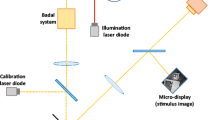Abstract
Using a subjective method of laser refractometry, the accommodation behavior of six subjects toward real targets with various degrees of blur, dependent on the viewing distance, were investigated monocularly and binocularly.
1. Despite the sharpness of the target, the nominal value is only reached incompletely with a lag of accommodation, because accommodation tends to be as minimal as possible.
2. Increasing blurring leads to a drift of accommodation towards the resting position of accommodation. The resulting underaccommodation causes further physiological blurring of the retinal image of the targets.
3. The approach of the targets to the resting position of accommodation leads to a higher precision of adjustment and less drift.
4. Subjective components (accommodative laziness, cognitive demand) influence the accommodation and increase the phenomenons discovered.
Similar content being viewed by others
References
Fincham EF (1951) The accommodation reflex and its stimulus. Br J Ophthalmol 35:381–393
Grimm W, Manneck E (1977) Subjektive Refraktionsbestimmung mit dem Laserrefraktometer. Augenoptiker 3:7–17
Hamerly JR, Dvorak CA (1981) Detection and discrimination of blur in edges and lines. J Opt Soc Am 71:448–452
Ingelstam E, Ragnarrson SI (1972) Eye refraction examined by aid of speckle pattern produced by coherent light. Vision Res 12:411–420
Knoll HA (1966) Measuring ametropia with a gas laser. Am J Optom 43:413–418
Krueger, H (1978) Schwankungen der Akkommodation des menschlichen Auges bei mon- und binokularer Beobachtung. Graefe's Arch Clin Exp Ophthalmol 205:129–133
Kruger PB (1980) The effect of cognitive demand on accommodation. Am J Optom Physiol Opt 57: 440–445
Morgan MW, Olmsted JM (1939) Quantitative measurements of relative accommodation and relative convergence. Proc Soc Exp Biol Med 41:303–307
Phillips S, Stark L (1977) Blur: A sufficient accommodative stimulus. Doc Ophthalmol 43:65–89
Toates FM (1972) Accommodation function of the human eye. Physiol Rev 52:828–863
Author information
Authors and Affiliations
Rights and permissions
About this article
Cite this article
Korge, A., Krueger, H. Influence of edge sharpness on the accommodation of the human eye. Graefe's Arch Clin Exp Ophthalmol 222, 26–28 (1984). https://doi.org/10.1007/BF02133773
Received:
Issue Date:
DOI: https://doi.org/10.1007/BF02133773




